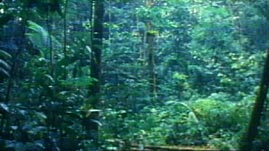Teachers' Domain - Digital Media for the Classroom and Professional Development
User: Preview

Source: Race to Save the Planet teaching module "Saving the Diversity of Life"
The tropical rainforests of the world are home to thousands of species of plants and animals -- including many that remain undiscovered by scientists. This video segment from the Race to Save the Planet teaching module "Saving the Diversity of Life" explores both the ecological importance and fragility of the rainforest biome and its organisms.
Tropical rainforests are the richest of all the world's biomes. Although these forests cover only about six percent of the earth's surface, they contain more than half of all living species of plants and animals, including hundreds of species of trees and thousands of species of insects. Perhaps more important, scientific research suggests that the ecological health of the planet as a whole hinges on the continued existence of tropical rainforests. For example, scientists estimate that tropical rainforest plants generate about 40 percent of the oxygen in the earth's atmosphere, and that, through evaporation, rainforests contribute water vapor that is essential for maintaining global weather patterns.
Yet every minute of every day, dozens of acres of tropical rainforest are cut down for the lumber they contain and to create farms and ranches. Somewhat surprisingly, efforts to turn rainforests into agricultural land have met with dismal failure. After two or three meager years, farmers and ranchers typically abandon their fields in search of new land and richer soil. Then they cut and burn more trees, converting another piece of productive rainforest into unproductive farmland.
The reason rainforest land is unsuitable for farming has to do with the soil — or, more precisely, what's not in the soil after the trees are removed. Unlike an intact rainforest, the soil that is left behind when a rainforest is cleared is horribly devoid of nutrients. This is because the majority of nutrients in this biome are locked up in the tissues of rainforest plants and animals. When these organisms are removed, the nutrients they contain are removed too. Even when trees are burned, a process that breaks down the wood and returns some nutrients to the soil, heavy rains often wash away huge amounts of unprotected soil, leaving behind land that is more depleted than ever.
Today, conservation efforts are aimed at educating local people about ways they can reclaim land that has already been cleared and use it in a more sustainable way to grow crops, raise cattle, and produce timber. Without such efforts, the world's tropical rainforests — and life on earth as we know it — may not survive.
NARRATOR: The Amazon rain forest of South America is home to over half of the plant and animal species on earth. Rain forests are chock full of a variety of living things unique to this habitat. There are so many species that scientists guess that millions more are waiting to be discovered.
We use many products which come only from rain forests like this. One quarter of the prescription medicines in the world come from rain forest plants. Rain forests are like hidden treasure chests for the planet. There might be new medicines or crops that we'll find, perhaps in a root here or a leaf there.
The trees of the mighty rain forest also soak up carbon dioxide, which helps our atmosphere. But the rain forest is being destroyed—chopped down, burned up and carved away. We're losing this land at the rate of a football field per second.
Brazil's rain forest is in high demand, both for peasants who need to feed their families and for rich businessmen who see great opportunities for profit. These people are clearing trees off the land so it can be used for cattle ranching, farming, mining, or to sell the trees for furniture wood. But some land development destroys the forest altogether.
To start with, the forest soils are extremely thin and poor. It's fine for the trees that grow here, but after just a few years of farming or raising cattle, the soil's nutrients are used up. The farmers and ranchers then abandon the dead land and move on to clear more rain forest. Aren't there ways that people can use the forest wisely?
 Loading Standards
Loading Standards Teachers' Domain is proud to be a Pathways portal to the National Science Digital Library.
Teachers' Domain is proud to be a Pathways portal to the National Science Digital Library.
